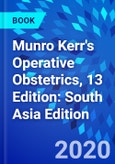This book has always primarily covered operative obstetrics, caesarean section in particular. Caesarean section has seen significant changes in practice since first introduced at? the time of Munro Kerr, so its coverage has been significantly increased to reflect current clinical thinking.
The authors have used the latest evidence from national guidelines and the Cochrane Database, and they have been encouraged to interpret and evaluate evidence in order to stimulate the reader to think deeper about the subject.
The book is divided into subsections: Chapters 1 to 7 covers the antepartum period; 8 to 33 cover labour and
delivery; 34 to 42 cover the postpartum period, and 43 and 44 cover the important organizational aspects. The? chapters are well illustrated with figures from the previous editions and newly commissioned figures. - Authoritative, world-known editors and author team.
- Presents a contemporary and pragmatic summary ofrecent developments in operative obstetrics.
- Contextualises practice in the history of obstetric practice.
- Accurate line drawings throughout clearly demonstrating relevant procedures and equipment.
- Advice and management for obstetricians working in resource-limited areas
The authors have used the latest evidence from national guidelines and the Cochrane Database, and they have been encouraged to interpret and evaluate evidence in order to stimulate the reader to think deeper about the subject.
The book is divided into subsections: Chapters 1 to 7 covers the antepartum period; 8 to 33 cover labour and
delivery; 34 to 42 cover the postpartum period, and 43 and 44 cover the important organizational aspects. The? chapters are well illustrated with figures from the previous editions and newly commissioned figures. - Authoritative, world-known editors and author team.
- Presents a contemporary and pragmatic summary ofrecent developments in operative obstetrics.
- Contextualises practice in the history of obstetric practice.
- Accurate line drawings throughout clearly demonstrating relevant procedures and equipment.
- Advice and management for obstetricians working in resource-limited areas
Table of Contents
Part I ANTENATAL1. Human birth
2. Preterm labour and delivery
3. Cervical cerclage
4. Antepartum haemorrhage: an overview
5. Vasa praevia
6. Abruption
7. Induction of labour
Part II LABOUR AND DELIVERY
8. Assessment and management of labour and delivery
9. Fetal surveillance in labour
10. Fetal asphyxia
11. Acute tocolysis
12. Cord prolapse
13. The use of oxytocin to accelerate or induce labour
14. Malpresentations and malposition
15. Assisted vaginal delivery: an overview
16. Assisted vaginal delivery: non-rotational forceps and manual rotation
17. Assisted vaginal delivery: vacuum
18. Assisted vaginal delivery: rotational forceps
19. Shoulder dystocia
20. Breech delivery
Lawrence Impey and Anita Hedditch
21. Twin and triplet delivery
22. Labour and delivery after previous caesarean
23. Uterine rupture
24. Caesarean section: controversies, audit and indications
25. Caesarean section: procedure
26. Caesarean section: clinical challenges
27. Additional procedures at caesarean section: salpionghectomy, myomectomy, ovarian surgery and hysterectomy
28. Placenta praevia and the morbidly adherent placenta
29. Haemorrhagic shock, disseminated intravascular coagulation and obstetric resuscitation
30. Thromboprophylaxis in labour and delivery
31. Amniotic fluid embolism
32. Analgesia and anaesthesia in labour and delivery
33. Labour and delivery in high-BMI women
Part III POSTPARTUM
34. Postpartum haemorrhage
35. Retained placenta
36. Uterine and vaginal tamponade
37. Uterine compression sutures
38. Pelvic vessel ligation and embolization: obstetric and radiological perspective
39. Lower genital tract trauma
40. Acute uterine inversion
41. Symphysiotomy
42. Destructive operations on the fetus
Part IV ORGANIZATIONAL ASPECTS
43. Perinatal audit in labour and delivery - safety, consistency and quality
44. Competence and skills training








